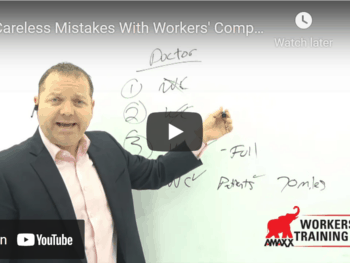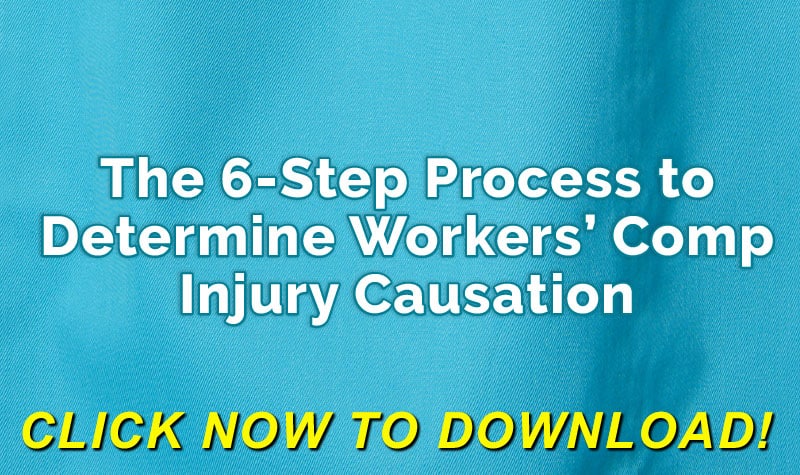Risk & Insurance
Full article on riskandinsurance.com
As workers’ compensation moves toward treatment that empowers and engages patients, episodes of care programs can offer improved outcomes for injured workers.
Episodes of care has become an important concept in value-based health care—one with the potential to create a substantial impact in workers’ compensation. The goal of an episodes of care-based program is to improve treatment by bundling services for an injury, illness or condition into a single event.
As an example, in treating a musculoskeletal injury such as a rotator cuff tear, payers can determine a price and hold providers accountable for delivering improved outcomes for the duration of the care episode. To receive the full negotiated rate, the provider must meet mutually established quality guidelines.
This integrated approach represents a solution that offers increased efficiencies, lower costs, and a better patient experience. “Rather than a disjointed and fragmented system, episodes of care incentivizes provider collaboration, use of evidence-based medicine, and guaranteed outcomes,” explained Kathy Galia, Paradigm Senior Vice President & General Manager, Clinical Solutions.
As workers’ compensation looks to improve functional recovery and effectively manage rising medical costs, fragmentation of care represents a major barrier. “Injured workers can find themselves in a very unsettling, uncomfortable situation from lack of knowledge about their medical condition, confusion about available treatments and pathways, and gaps in care,” said Michael Choo, MD, Chief Medical Officer for Paradigm. “Too often, this leads to increased costs from unnecessary or low-value treatments, prolonged duration of claims, and delayed return to work.”
“Our goal as an industry should be to remove these barriers and increase patient engagement,” Dr. Choo continued. “Putting episodes of care programs into practice creates a clear path forward to better communication and greater access to top providers. In workers’ compensation, this leads to improved outcomes for injured workers, more provider alignment, and sustained financial predictability.”
How Fee-for-Service Models Drive Disjointed Care and Higher Costs
According to Galia and Dr. Choo, it’s easy for workers in the current system to feel like they are “going it alone.” This is particularly true in the case of relatively low-severity musculoskeletal injuries. As an example, they shared the typical steps that a patient with a workplace rotator cuff injury can expect to encounter.
“Following an injury, this worker will usually be evaluated and referred to multiple providers. He or she may go to a radiology specialist for diagnostic imagery, a pharmacist for various prescription medications, a durable medical equipment provider, a physical therapist for rehab, and even a pain management specialist for corticosteroid injections,” explained Dr. Choo. After some initial conservative therapies are explored, surgical consultations are typically obtained in many situations.
Billing separately for these services drives volume of care—and costs—upward. According to an analysis of episode of care-based payments conducted by the RAND Corporation,1 reimbursement for individual services was associated with cost increases in the millions of dollars, compared to a bundled payment approach. One episode-based payment program cited by the study resulted in $52.3 million in total savings to Medicare.
“Under a standard fee-for-service model, providers bill separately and generally do not coordinate all treatment,” added Galia. In the workers’ compensation world, a claims representative for the payer will either schedule services or encourage patients to schedule treatments themselves. Dr. Choo elaborated, “These untethered schedule- or appointment-based timetables can create a paradoxical effect that delays return to work if injured workers aren’t getting the appropriate care and attention they need in a timely manner.”
From a patient care standpoint, this all adds up to significant fragmentation in the care process. “There is a lack of guidance for the overall trajectory of treatment, and patients often report feeling uneducated and unsure about next steps,” said Galia. “Industry research consistently points to dissatisfaction with disjointed care from participants and stakeholders across workers’ compensation.”2
On the provider side, this system also creates incentives for providing services instead of achieving an outcome. Because of this, fee-for-service billing has become a significant driver of increasing costs in workers’ compensation and general health care alike. As Galia put it, “Lack of patient engagement in the treatment process, combined with misaligned incentives for volume of service, hinders recovery.”
One prominent example of increased volume of service is unnecessary surgery. According to the American Academy of Orthopaedic Surgeons, approximately 80% of patients with shoulder injuries are able to obtain relief through nonsurgical treatment. When compared to data that shows a consistent increase in the rate of shoulder surgeries,3 there are indicators that many workers may be undergoing shoulder surgery before it is necessary. Added Dr. Choo, “In the area of shoulder injuries, patients should not be undergoing surgery when nonsurgical treatments can achieve similar effective outcomes at a lower cost. This would help avoid risks from invasive procedures.”
Key Components for Better Outcomes—Guided Expertise, Predictive Data, Patient-Centric Technology, and Access to Top Providers
Care management programs in workers’ compensation built around episodes of care offer an alternative to health care fragmentation and fee-for-service models. “The primary goal is to deliver a dedicated care manager who acts as a partner to injured workers,” said Galia. “When this approach is backed by clinical expertise and predictive data, it creates an enhanced ability to guide outcome pathways in a cost-effective and patient-centric way.”
Technology is underutilized in workers’ compensation in general, and episodes of care programs will provide an exciting opportunity to create two-way platforms that benefit all parties. “Patient engagement apps can give injured workers increased information and education about their care, while coordinators gain critical data that can drive better collaboration with providers,” explained Dr. Choo. “This data not only benefits that individual case, but it can also help provide insights to drive better outcomes on an aggregate level for future patients.”
Another fundamental component of effective episodes of care-based treatment in workers’ compensation involves access to high-quality providers. As Dr. Choo said, “Successful managed networks that drive accountability and collaboration require rigorous selection standards and an outcome-based payment model that incentivizes positive clinical results.”
Ultimately, these components must all work together to deliver better outcomes and increased engagement for patients, while lowering costs for payers. “At Paradigm, we have spent decades achieving clear progress in value-based care for catastrophic injuries, delivering financial predictability and guaranteed outcomes,” said Galia. “An episodes of care model that treats a broader range of injury types has the potential to bring those same cost and patient care advantages to even more people.”
A Guided Trajectory Built on Episodes of Care
Continuing with the example of a worker recovering from a shoulder injury, an episodes of care platform in the workers’ compensation system would engage early, starting during the conservative phase of treatment. “The goal is to increase real-time communication and support of the whole person to foster a positive, recovery-focused mindset,” said Galia.
“Ideally, coordinators would match an injured worker with the best provider, based on established care pathways, combined with their unique patient performance data,” explained Dr. Choo. With the assistance of dedicated patient-facing applications, injured workers can receive critical information early and often, from appointment reminders to educational materials. “Additionally, technology can facilitate coordination with ancillary providers, from physical therapists to home health services.”
Clinical experts, including physicians and registered nurses on both the provider and care management side, will play a key role in helping to ensure that treatment stays on track, or taking the appropriate action to respond to any emergent issues.
“For example, if the patient’s injury recovery path requires a move from conservative to surgical care, this model can ensure that they’re matched with the right surgical provider,” said Dr. Choo. “The objective is to ensure that every surgery is necessary for achieving the better outcome—and has fully informed consent from the patient.” Once the surgery is completed, the focus will then shift to keeping the injured worker engaged and focused on rehabilitation during the critical days and weeks after the procedure. Dr. Choo finished by saying, “Ultimately, episodes of care has a strong capacity to shepherd both providers and patients toward optimal recovery and a release to return to work.”
“Moving toward integrated, outcomes-focused treatment bundling and away from fragmented, time-based, fee-for-service models offers an increased potential for driving cost-effective treatment that achieves higher return-to-work rates,” explained Galia. “We believe the key to accomplishing this is a holistic care management solution that delivers end-to-end service for an injured worker’s entire episode of care—all in the most seamless and engaging way possible.”
Kevin Turner, Chief Clinical Solutions Officer, Paradigm
Michael Choo, MD, MBA, FACEP, FAAEM, CMRO, Chief Medical Officer, Paradigm
Kathy Galia, Senior Vice President & General Manager, Clinical Solutions, Paradigm
1Source: Analysis of Bundled Payment, Rand Corporation.
2Source: Paradigm Proprietary Research, 2018.
3Sources: Paloneva, Juha et al. “Increasing incidence of rotator cuff repairs—A nationwide registry study in Finland,” NCBI. Web. Aug. 12, 2015 and Wagner MD, Eric R. et al. “The incidence of shoulder arthroplasty: rise and future projections compared with hip and knee arthroplasty,” Journal of Shoulder and Elbow Surgery, Basic Science, Volume 29, Issue 12, P2601-2609, Published: June 09, 2020. Web. December 01, 2020















 Employers Wrongly Have Fear of Communicating Work Comp
Employers Wrongly Have Fear of Communicating Work Comp
